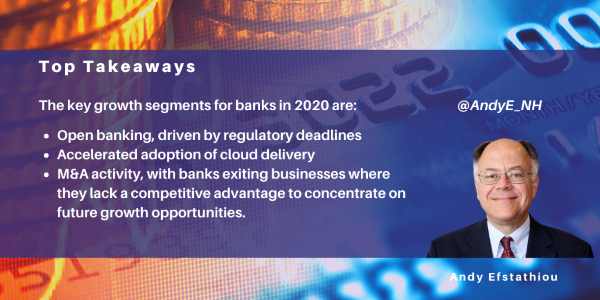posted on Jan 22, 2020 by Andy Efstathiou

Banks will spend 2020 pursuing three key initiatives that have not been a priority in the past. Two of them, open banking and cloud delivery, are technology environments that have just recently matured to the extent that banks are able to drive business model change with them. The third priority is M&A driving large ITS engagements, and is typical of late-stage economic cycle activity. However, we are in a ten-year long economic expansion, and high levels of M&A have not been seen since the last late cycle stage.
Open Banking
Regulatory deadlines are driving open banking adoption, and Europe is the leader in open banking regulation. The two key regulations PSD2 (European) and The Open Banking Standard (U.K.) had go-live dates in September 2019, and the trend started strongly in the closing months of 2019. In the U.K. from Sept. to Oct. 2019, the number of regulated providers was up 4.4% and the number of regulated entities with a live offering to customers was up 9.4%. Those numbers run at ~200% per year growth when annualized, and the pace will accelerate in 2020.
Our conversations with bank executives indicate their highest business priorities are:
- Increasing average revenue per customer
- Launching new products and services to generate new revenue streams.
In 2020, they will focus their open banking initiatives on customer services, online commerce, and payments to drive customer acquisition and revenue growth.
Cloud Delivery
Banks are moving to the cloud to reduce time-to-market and cost of delivery, and are moving to hybrid multi-cloud environments. Hybrid cloud, the use of private and public clouds, will remain the paradigm of choice. In 2020, the use of public cloud will accelerate aggressively, with tier one banks increasing their allocation to public cloud from the current 3% of overall IT environment to 6% by mid-2021. Multi-cloud, the use of multiple cloud vendors (e.g. AWS, Azure, Google, IBM, etc.) will also increase. AWS was very early to the cloud game and has developed strong functionality. New vendors are rapidly building cloud capabilities (such as consumer data management capabilities at Google) which will target specific workloads. Increasingly, banks will engage with cloud vendors for specific workloads due to proprietary functionality.
IT services vendors will support banks’ initiatives by delivering cloud services with cognitive-enabled operations using proprietary components to support business model change. The new business models will focus on rapidly introducing new low-margin bank products, which have low financial risk. This will allow banks to focus less effort on portfolio risk management and more effort on increasing sales per customer. Expect to see an explosion of deposit products and highly standardized consumer credit products. Many of these products will have much lower sales than were needed in the past. However, low-cost cloud delivery will drop breakeven for each product, allowing for the profitable expansion of low-volume products targeted at consumer life-stage needs.
M&A
M&A by banks grew in 2019 and will accelerate in 2020. Banks are exiting businesses where they lack a competitive advantage and are selling those businesses to concentrate on future growth opportunities. Most sales are to other banks, but in some cases banks are selling their operations centers to third-party services vendors. For example, recently, Cognizant acquired the operations of three Nordic Banks which were joined into one vehicle, Samlink.
M&A deals derive most of their value from a rapid transition to integration into the acquiring organization. The integration process requires ITS to integrate technology systems and business process management services to integrate operations across the two institutions.
Successful, rapid integration requires burst support in order to transition operations rapidly to the final state. Third-party services vendors are the only available source for skilled labor at scale on short notice. Core banking platform expertise will be key to winning deals, but digital technologies will be required to support the agility needed to cost-effectively re-engineer the operations of both the acquiring and acquired banks. We expect M&A deals will drive even faster movement by banks into cloud delivery, especially public cloud environments.
Each of these three growth segments will provide banks with increased agility to adapt to a rapidly changing business environment. The agility developed will be useful to banks after 2020 as they change their business models once again to address Brexit and the changing financial environment in Asia.
